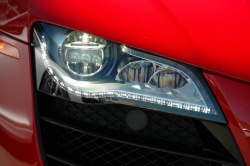 2010 Audi R8 5.2 V10; photo by Paul Williams. Click image to enlarge |
By Jim Kerr
Vehicle headlights switched from incandescent lighting, which had been in use since the early 1940s to halogen lights back in the late ’70s. The lights were still sealed beam units but the improvement in lighting was remarkable at the time. By the early 1980s, regulations were changed to allow replaceable bulbs in headlights and this allowed the auto manufacturers to style the headlamps as part of the body’s overall design.
In the past decade, we have taken another giant step forward in headlamps, with High Intensity Discharge lights, sometimes called xenon lights, which the manufacturers claim put out up to 60 per cent more light than a conventional halogen light while at the same time consuming much less power. The latest in headlight technology is LED (Light Emitting Diode) lighting. There are several vehicles on the market that use LED lighting for daytime running lights and the Audi R8 introduced LED headlights to the marketplace. LED’s are silicone-based semiconductors that convert electricity into light and do it very efficiently. They are small in size, produce very little heat and have increased durability over filament type bulbs, which will make them one of the main lighting choices of automotive manufacturers in the future.
While LED’s are the future for headlights, those of us with older lighting systems can improve our vehicle lighting. Older vehicles that use sealed beam headlamps can be converted to lights that use replaceable bulbs. There are several manufacturers of these lights and each has lenses that provide a distinctive lighting pattern on the road so be sure to compare them before buying. Newer vehicles already have headlamps with replaceable bulbs, so you don’t have to change the complete assemblies, only the bulbs.
There are many headlight bulbs on the market. There are standards for headlight bulbs, but these typically pertain only to mounting design, connector configuration and the colour temperature of the light the bulb produces. OEM car manufacturers typically equip their vehicles with bulbs in the 4100 to 4300 Kelvin range. This produces light most like daylight in colour. You may have seen some headlights with bluish or purple tints. These lights operate in the 5000 to 6000 Kelvin range. A higher colour temperature doesn’t mean there is more light on the road – it only changes the colour the bulb produces. Whatever bulb you choose be sure they have DOT (Department of Transport) symbol on them or they won’t meet on-highway vehicle standards.
There are premium halogen headlight bulbs on the market. I recently installed a set of General Electric Nighthawk bulbs in one of my vehicles and the difference over the existing halogen bulbs was amazing. GE claims the Nighthawk bulbs produce up to 90 per cent more light on the road. While I can’t confirm this, they do provide a lot more light.
Beware of cheap headlight bulbs. They may not be built to the same quality and can position the filament of the bulb in a slightly different position. This can create a dramatic decrease in illumination.
Headlamps get their focus and pattern either by directing the light through a projector lens, or by bouncing it off of a reflector. In either case, the bulb filament must be positioned correctly so the light beams are focused by the lens or reflector in the correct spot.
There are now many companies marketing HID Xenon or Bi-xenon light conversion kits. Bi-xenon lights are Xenon bulbs that are used for both high and low beam operation. A small electric motor moves a shield in the bulb to redirect the light for the desired beam pattern. These bulbs produce light from an electric arc inside the bulb instead of a glowing filament like the Halogen bulbs do. To produce the arc, a small module converts the battery voltage to a much higher voltage so the arc will jump the gap. The module then keeps the arc going. These conversion kits come with the new bulbs and modules and do produce more light, just like the factory Xenon lights do, but again, there are variances in quality. Cheapest isn’t always the best.
There aren’t any LED conversion kits for headlamps on the market yet, but there are lots of LED bulbs available for every other light on your vehicle. LED bulbs are bright, turn on quicker (an advantage for brake lights) and last longer. You don’t have to drive like your car came from the dark ages. Good lights make for safer and more relaxing night time driving.







 Follow Autos on Twitter
Follow Autos on Twitter



